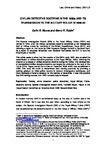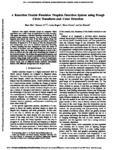Civilian Detective Doctrine in the 1930s and its Transmission to the Military Police in 1940-42

Date
2014Author
Subject
Metadata
Show full item recordAbstract
The Special Investigation Branch (SIB) of the Royal Military Police (RMP) was formed in 1940, after the military authorities became concerned at the widespread theft of military stores by members of the British Expeditionary Force (BEF), and following a report on the matter by Chief Inspector George Hatherill of Scotland Yard. As a result 19 volunteer detectives from Scotland Yard joined the BEF to form the initial intake of the SIB. This article seeks to show that the creation of the SIB in early 1940, also entailed the transmission of civilian detective practices to the Royal Military Police, following the creation of a corpus of civilian detective doctrine during the 1930s. The development of standardised civilian detective doctrine can largely be attributed to the work of the Home Office Departmental Committee on Detective Work which was established in 1933. This body did much to disseminate best training practices by providing a training syllabus for initial police recruits in relevant investigative techniques, and more relevantly offered a syllabus for the training of detectives. It was this doctrine that SIB training courses from 1942 onwards duly embraced.
Citation
Moore, C. and Rubin, G.R. (2015) 'Civilian Detective Doctrine in the 1930s and its Transmission to the Military Police in 1940-42.’, Law, Crime and History, 4(3), pp. 1-30. Available at: https://pearl.plymouth.ac.uk/handle/10026.1/8905
Collections
Publisher
Journal
Volume
Issue
Recommended, similar items
The following license files are associated with this item:
Related items
Showing items related by title, author, creator and subject.
-
Object detection standards and requirements: Influence of survey strategy on object detection capabilities of swathe bathymetry echosounders
Trebaol, Christophe (University of Plymouth, 2010)The International Hydrographic Organisation (IHO) and the Land Information New Zealand (LINZ) publishes international hydrographic standards in which they define survey specification and guidance for the undertaking of ... -
A Real-time Double Emulsion Droplets Detection System using Hough Circle Transform and Color Detection
Zhu, S; Li, Chunxu; Rogers, J; Gianni, Mario; Howard, Ian (IEEE, 2021-11-26)The object detection based on computer vision algorithms has a wide range of applications in many domains. This paper introduces a real-time detection methodology of 3D printed double emulsion droplets. The first step is ... -
Anatomy of Deep Learning Image Classification and Object Detection on Commercial Edge Devices: A Case Study on Face Mask Detection
Dimitrios, K; Kelefouras, Vasileios; PANDELIS, K; Iosif, M (Institute of Electrical and Electronics Engineers, 2022-10-13)Developing efficient on-the-edge Deep Learning (DL) applications is a challenging and non-trivial task, as first different DL models need to be explored with different trade-offs between accuracy and complexity, second, ...




